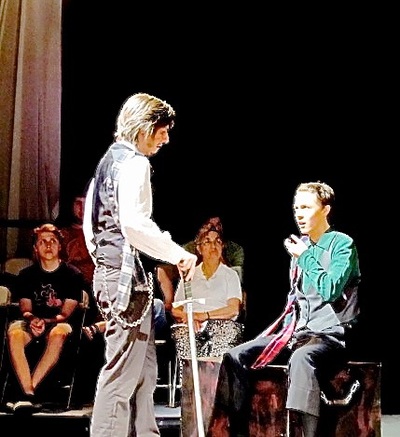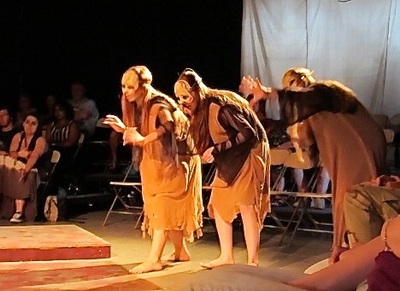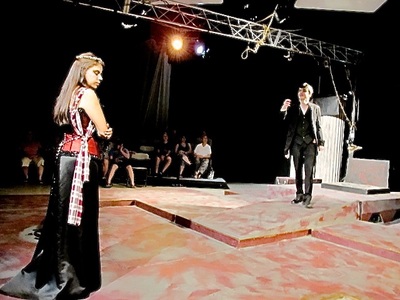Costume Design Unit
Technical Theatre Design Grade 10
Enduring Understanding:
An actor frequently uses a costume as the final step to really connect to a character. Designing the costumes for a play require very close reading of the script to see the author's intention. You must also read for context clues that will determine what style and colors the character will wear to help the audience understand what sort of character the actor is meant to be. For example, a jealous lover may wear green in western theatre (in eastern theatre green is for demons) or an angry character in western theatre may have elements of red in his/her costume (whereas red in eastern theatre is for heroes).
Essential Questions:
How do you read a play for design? What is the significance of costumes? Does the costuming reflect the author's intentions? What does costuming do for an actor? Do particular styles and colors chosen for certain characters matter? What do you research for costuming?
Students will know:
Students will be able to:
Activities:
Activities for ALL students:
Activity 1 -
Read and interpret Macbeth by William Shakespeare as a costumer. Take notes and pay attention to the subtleties in the author's words. Draw conclusions about the characters and their personalities based on context clues.
Activity 2 -
Research clothing from a decade of the 20th Century. Find clothing that reflects best that decade (not a stereotype i.e. all 60's are hippies) according to the character. What this means is if you are dressing a noble character in the 1980's, That character would most likely be wearing fine and/or formal clothing. You may modify the clothing as a base for what your imagination lets you do, such as looking up Goth clothing from the 1990's can inform your modern take on Goth garb.
Activity 3 -
Draw three characters (one male human, one female human, one witch). Use the Costume Mannequin provided.
Activity 4 -
Students will show their costume designs both in progress and at the final stage to their peers for critique in an open forum.
Activities for MOST students:
Will have a well researched concept for their interpretation of 20th Century costuming.
Will respond and inquire during peer critiques.
Take and create a presentation for their costume design.
Activities for SOME students:
Will exceed their own expectations and push the limits of what they think is possible.
Create a presentation that is worthy of an IE presentation at Thespian Conference (see extended rubric below).
Create a piece of the costume or complete more research with swatches of fabric/or find what the cost of the costumes would be.
Content Standards:
TH:Cr1.1.HSI
a. Apply basic research to construct ideas about the visual composition of a drama/theatre work.
b. Explore the impact of technology on design choices in a drama/theatre work.
TH:Cr1.1.HSII
a. Investigate historical and cultural conventions and their impact on the visual composition of a drama/theatre work.
b. Understand and apply technology to design solutions for a drama/theatre work.
TH:Pr5.1.HSIII
b. Explain and justify the selection of technical elements used to build a design that communicates the concept of a drama/theatre production. - See more at: TH:Re9.1.HSII
a. Analyze and assess a drama/theatre work by connecting it to art forms, history, culture, and other disciplines using supporting evidence and criteria.
b. Construct meaning in a drama/theatre work, considering personal aesthetics and knowledge of production elements while respecting others’ interpretations.
c. Verify how a drama/theatre work communicates for a specific purpose and audience.
Instructional Resources:
Technical Theatre Design Grade 10
Enduring Understanding:
An actor frequently uses a costume as the final step to really connect to a character. Designing the costumes for a play require very close reading of the script to see the author's intention. You must also read for context clues that will determine what style and colors the character will wear to help the audience understand what sort of character the actor is meant to be. For example, a jealous lover may wear green in western theatre (in eastern theatre green is for demons) or an angry character in western theatre may have elements of red in his/her costume (whereas red in eastern theatre is for heroes).
Essential Questions:
How do you read a play for design? What is the significance of costumes? Does the costuming reflect the author's intentions? What does costuming do for an actor? Do particular styles and colors chosen for certain characters matter? What do you research for costuming?
Students will know:
- How to closely read a script as a costume designer.
- How to design costumes on paper.
- The proportions of the human figure.
- Different styles throughout eastern and western history.
Students will be able to:
- Interpret a script as a designer.
- Create drawings representative of their costumes.
- Create a costume plot that reflects an era based on a play from Shakespeare.
- Group critique
- NIEs standard rubric for technical design.
Activities:
Activities for ALL students:
Activity 1 -
Read and interpret Macbeth by William Shakespeare as a costumer. Take notes and pay attention to the subtleties in the author's words. Draw conclusions about the characters and their personalities based on context clues.
Activity 2 -
Research clothing from a decade of the 20th Century. Find clothing that reflects best that decade (not a stereotype i.e. all 60's are hippies) according to the character. What this means is if you are dressing a noble character in the 1980's, That character would most likely be wearing fine and/or formal clothing. You may modify the clothing as a base for what your imagination lets you do, such as looking up Goth clothing from the 1990's can inform your modern take on Goth garb.
Activity 3 -
Draw three characters (one male human, one female human, one witch). Use the Costume Mannequin provided.
Activity 4 -
Students will show their costume designs both in progress and at the final stage to their peers for critique in an open forum.
Activities for MOST students:
Will have a well researched concept for their interpretation of 20th Century costuming.
Will respond and inquire during peer critiques.
Take and create a presentation for their costume design.
Activities for SOME students:
Will exceed their own expectations and push the limits of what they think is possible.
Create a presentation that is worthy of an IE presentation at Thespian Conference (see extended rubric below).
Create a piece of the costume or complete more research with swatches of fabric/or find what the cost of the costumes would be.
Content Standards:
TH:Cr1.1.HSI
a. Apply basic research to construct ideas about the visual composition of a drama/theatre work.
b. Explore the impact of technology on design choices in a drama/theatre work.
TH:Cr1.1.HSII
a. Investigate historical and cultural conventions and their impact on the visual composition of a drama/theatre work.
b. Understand and apply technology to design solutions for a drama/theatre work.
TH:Pr5.1.HSIII
b. Explain and justify the selection of technical elements used to build a design that communicates the concept of a drama/theatre production. - See more at: TH:Re9.1.HSII
a. Analyze and assess a drama/theatre work by connecting it to art forms, history, culture, and other disciplines using supporting evidence and criteria.
b. Construct meaning in a drama/theatre work, considering personal aesthetics and knowledge of production elements while respecting others’ interpretations.
c. Verify how a drama/theatre work communicates for a specific purpose and audience.
Instructional Resources:
| |||||||
| nies_assessment_form_hs_costume_construction_2015-2016_v1_final.pdf | |
| File Size: | 175 kb |
| File Type: | |
| |||||||













